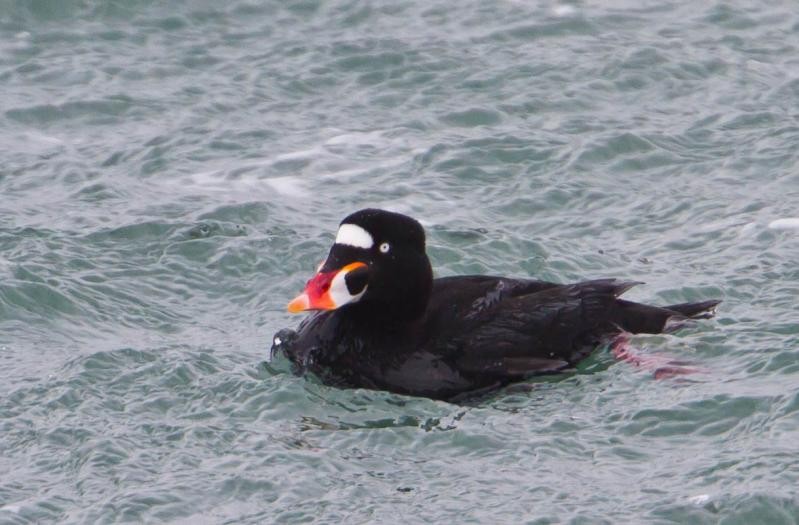Surf Scoter
A species of Scoters Scientific name : Melanitta perspicillata Genus : Scoters
Surf Scoter, A species of Scoters
Botanical name: Melanitta perspicillata
Genus: Scoters
Description
The adult male is on average 1,050 g (2.31 lb) and 48 cm (19 in) in length while the adult female averages about 900 g (2.0 lb) and 44 cm (17 in) in length, making this the smallest species of scoter on average. The surf scoter has a wingspan of 29.9-30.3 in (76-77 cm). The male is completely velvety black except for white patches on the forehead and the nape. It has a swollen bill, appearing orange at a distance but patterned with white, red and yellow, and a black spot near the base. The female is browner than the male, with a fairly uniform plumage, slightly darker above than below. Indistinct paler patches are present on the cheeks below the eye and sometimes a whitish patch is on the nape, a unique trait among scoters. The bill is black with green or blue colorations The juvenile has a plumage similar to the female, but mainly paler and browner, and the breast and belly are whitish The surf scoter is easily distinguishable from other scoters by the white patch on the head of the adult male and its unique bill pattern. Females and immatures have a bulkier bill and a more flattened head profile than other scoters, recalling the shape of the common eider (Somateria mollissima). The black and the white-winged scoters are physically very similar to the surf scoter but in flight, the surf scoter is the only one with completely dark wings. Like all sea ducks, the surf scoter becomes flightless during the simultaneous molt of its flight feathers. This vulnerable period happens usually in late July through early August and lasts for about four weeks. Before molting the flight feathers, all waterfowl undergo a complete body molt, replacing the bright colors of the basic plumage of males by the duller alternate or eclipse plumage. The plumage is a good indicator of the age for male surf scoters, but not for females. 
Size
43-53 cm (17-21 in)
Life Expectancy
9.5-11 years
Nest Placement
Ground
Clutch Size
6 - 9 eggs
Incubation Period
1 brood
Number of Broods
28 - 30 days
Feeding Habits
Surf Scoter principally consumes benthic invertebrates, such as small mollusks, mussels, clams, marine snails, crabs, sea squirts, hydrozoans, and marine worms. Surf Scoter also eats herring spawn and aquatic vegetation, while freshwater invertebrates and plant matter are part of the diet during breeding.
Habitat
Surf Scoter occupy coastal wetlands and inland habitats, predominantly along the taiga shield where boreal forest meets tundra. They nest beside medium-sized lakes and use multiple water bodies for foraging. In non-breeding seasons, surf Scoter are found in nearshore oceanic zones, retreating offshore at night and seeking sheltered bays during storms.
Nest Behavior
During the nesting period, surf Scoter builds the nest, lays eggs, and tends to the young. Females are responsible for nest construction and incubation. Post hatching, offspring care is primarily the mother's role as she leads her brood to water soon after they emerge.
Nest Characteristics
Surf Scoter's nest is typically concealed on the ground beneath vegetation or rocky ledges near a lake, often away from marshes. The female forms the nest bowl, lining it with plant materials like mosses, grasses, and twigs, as well as her own down feathers. Nests average 12 inches across and 2.4 inches deep.
Dite type
Aquatic invertebrate eater
People often ask
Migration Overview
Many migration routes have been observed, and the route choice of the surf scoter will depend on the latitude of its nesting site. The departure date of the birds may vary according to their wintering site, but the date of arrival and settling on the nesting site appear to be synchronous. This suggest that because of different factors such as the weather or varied foraging conditions, the individuals adjust their migration timing to meet an optimized reproductive schedule. The ducks face very different environmental conditions depending on the location of their wintering grounds, which affect their migratory behavior. Higher proportions of males have been located in the northern part while more females and juveniles winter in the southernmost portion of the range. In spring, males and females migrate together to their breeding area and they usually settle at their nesting sites less than a week after arrival. 
General Info
Feeding Habits
Bird food type
Behavior
Surf Scoter exhibit dynamic daily activities, often engaging in conspicuous courtship displays in wintering coastal areas. Males perform unique behaviors including the 'sentinel posture', bobbing their colorful bills in the water, head-shaking, vigorous preening, and gurgling calls to attract females. They energetically rear up from the water and execute short flights to showcase superiority, impressing females who may respond with 'chin-lift' gestures and crowing calls. Outside mating rituals, surf Scoter congregate in substantial flocks during migrations and molting periods. In serene environments, these groups are audible from a distance, producing characteristic whistling sounds through their wingbeats. Their behaviors indicate a highly interactive species, adept at utilizing their habitat for social and survival purposes.
Distribution Area
Compared to most Northern American sea ducks, the surf scoter breeds exclusively in North America, mostly in Northern Canada and Alaska. Then, they take different migration routes to spend the winter in more temperate environments. While small numbers regularly winter in western Europe as far south as the British Isles, the vast majority of surf scoters winter along the Pacific and Atlantic coasts of North America. The Pacific coast host the highest number of individuals and its large wintering range extends over 5000 km, from the Aleutian Islands in Alaska to the Baja Peninsula in Mexico. 
Species Status
Not globally threatened.
